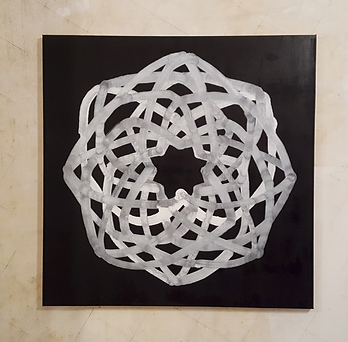Marie Cloquet
TRAVELING LIGHT
08/09/2019 - 20/10/2019
Marc Rossignol
Synchrone
Opening Sunday 9 September 2018
Marc Rossignol
Synchrone
Opening Sunday 9 September 2018
Marc Rossignol
Synchrone
Opening Sunday 9 September 2018
Marc Rossignol
Synchrone
Opening Sunday 9 September 2018
Herman Van Ingelgem
Foreign Bodies & Protheses
06/09/2021 - 17/10/2021
Annie Gentils Gallery
Marie Cloquet – Traveling Light - 08.09.2019 / 20.10.2019
The Search for the New Land
Preliminary Notes on Marie Cloquet’s Work
The more I reflect on Marie Cloquet’s work, the more it appears to me as a peculiar form of Land Art. In her work, Cloquet creates new landscapes by altering and modifying real landscapes. She intervenes in the landscape, rearranging it, rendering it indistinguishable from the images within which it is generated, the papers on which these images are printed, etc.
Cloquet’s images are not representations of landscapes that exist outside the images. They are collage driven hybrid landscapes, both actual and illusionistic, made of, in, and by fragments and patches of real landscapes. They turn segmented elements of landscapes into pictorial elements, and the other way around. In this sense, one should refer to Cloquet’s work as a physical act of photographic dislocation, transposition, reconstruction.
The Image of Cloquet’s work cannot be defined as an outcome of optical recording or purely visual organization. It stems from a material friction shifting the artist’s body between a variety of textures, phases of matter, and topographies. It is a tactile, haptic, corporeal entity, an inconsistent hybrid landscape whose textural, chemical, and topographical shifts expose the viewer’s field of vision to the cracks therein. Due to the different landscapes it welds together, the Image of Cloquet’s work engenders ruptures and rifts along the stitching lines between them. It deconstructs the notion of the Image and our perception of the world as a persistent, regulated picture.
Cloquet’s hybrid landscapes are more than a constant exchange between physical intervention and photographic dislocation. They also function as a material support, as the ground surface of watercolor paintings. When absorbed in transparent layers of watercolors, Cloquet’s hybrid landscapes undergo an additional transformation, becoming a screened image, a process of appearance emerging through a transparent partition, and at the same time, a hazy sight behind layers of watercolors. The transparent screen of watercolors smoothens the cracks between the different photographic landscape patches, consolidating them into an image of evocation. It assumes their appearance through the transparent screen of the watercolors as a result of recollection. However, it also pushes the landscapes backwards, keeping them behind the transparent screen as an indication of a failed recollection, as an elusive vision. Paradoxically, the painterly transparent screen of Cloquet’s hybrid landscapes does not operate as a fictional artificial factor but opens them up to a horizon of memory. It situates them in affinity to the category of the archive, yet, concurrently, it incorporates this category into procedures of obscurity, of screening, of loss.
The painterly element of Cloquet’s work marks her strive for color against the black & white background of her landscapes. The rare and short trails of colors hovering above her colorless photographic topographies throw us back to the days following the invention of (black & white) photography, and of hand-painted photographs, as a means of reviving images. They recall Jean-Luc Godard’s statement that photography and cinema were born as a melancholic expression of mourning, that initially their black & white imagery was a demonstration of loss.
Cloquet’s interplay of Land Art, photography, and painting stages an event of declassification, an undifferentiated constellation of places and times, an idiosyncratic experience of the world. It combines varying registers of reality, undermining the distinction between phases of matter, between the animate and the inanimate, the substantial and the imaginary. It exercises a fluid, elastic state of things established upon a potential of primal energy by which everything can be recreated over again.
Ory Dessau
.png)
.png)


